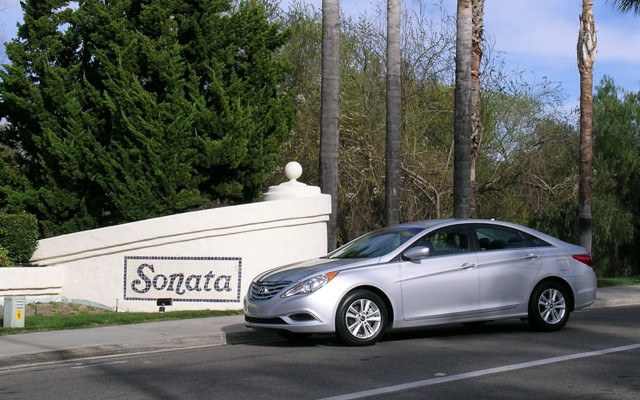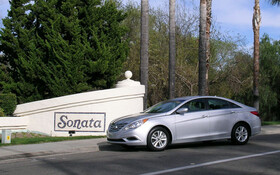The 2011 Hyundai Sonata, ain’t she pretty!

| Strong points |
|
|---|---|
| Weak points |
|
During the recent launch of the 2010 Hyundai Tucson, I mentioned that this Korean manufacturer has had the wind in its sails for quite some time. Recession? What recession? With its share of the market practically doubling in the last year, Hyundai is now part of that club of automobile manufacturers selling more than 100,000 units in Canada in just a year. Nothing to scoff at. So, if you still think of Hyundai in the same terms as you did 10 or 15 years ago, it’s time you think again!
Hyundai made the most of the recession and upped its positioning with well-adapted and fuel-efficient vehicles. Plus, its network of dealerships expanded throughout the country, while GM dealerships were abandoned. In short, it was probably the best period in history for Hyundai, which has gone from simply offering cheap products to featuring a line of vehicles that are as interesting as what the Japanese are producing.
The new Sonata’s got style
Once again, this manufacturer has embarked on a major overhaul, with seven new products in 24 months. It all began a few weeks ago with the launch of the new Tucson. Now, it’s the Sonata, an intermediate sedan, that has gone under the knife. At first glance, it’s hard not to be charmed by its new lines. It has the look of a luxury vehicle, belying the fact that it is quite an affordable sedan.
Designed at Hyundai’s studio in Irvine, California, the 2011 Sonata steals some style from four-door sport coupes. Mercedes-Benz kicked off this trend with its CLS-Class, then Volkwagen’s Passat CC followed suit, but this is the first time that we’ve seen it on a more affordable vehicle. Is the design inspired from others? You bet, but in the case of the new Sonata, it suits the vehicle perfectly – particularly the front end, with its sculpted lines and wonderfully revamped front grille. The plunging V nose translates into an excellent drag coefficient; combine this with other features and you get great fuel economy. The rear also looks great, with the stylized tail lights that stretch onto the sides of the vehicle. At the launch, we were able to see the sport version reserved for our southern neighbours. It includes dual oval exhaust tips, not unlike what you see on the Mazda6. While these don’t add much to the vehicle’s performance, we found they added a lot to its looks – particularly when compared to other versions, which had a rather "timid" exhaust pipe under the bumper and not even a chrome tip. It’s too bad, a dual exhaust would certainly have given this car more character.
Three versions, one engine, no V6
For the 2011 model year, the selection has been simplified. Starting at $24,249, the Sonata comes in three versions, the GL, the GLS, and at the top of the line, the Limited. They all have the same mechanics: a 2.4-litre four-cylinder engine that produces 198 hp and 184 lbs-ft of torque. This very modern engine is very interesting indeed, thanks to the direct fuel injection, which optimizes its efficiency and fuel consumption. This engine can be paired with a six-speed manual transmission (available on the base model) or a six-speed automatic (on the two more costly versions).
You may have noticed the absence of a V6 in this equation. While the four-cylinder does a pretty decent job, a V6 would have done wonders for this vehicle’s image, even if this type of engine really only accounts for 10-20% of the competition’s sales. In a lot of people’s minds, a four-cylinder is inadequate for an intermediate sedan – especially people south of the border. Hyundai will have to work hard to change this perception, but since new, stricter anti-pollution regulations are set to come out soon, other manufacturers are likely to follow suit.
If the outside lines are a success, the interior is not too shabby either, though perhaps not as dazzling as the exterior. There’s still some hard plastic, and the central part of the dash, while nicely presented, is rather sober. The instrument panel, however, is decidedly more modern. Slightly bigger this year, the Sonata offers what is probably the largest interior in its category. In fact, no longer considered an intermediate, the Sonata joins the Honda Accord in the large sedan category. This means plenty of space for passengers, both in the front and back.
On the road
Driving the Sonata is pleasant. While it’s not the sportiest ride, it’s comfortable and, above all, very quiet. Its four-cylinder engine is well adapted and it’s got enough pick-up for enjoyable and safe driving. Paired with the automatic six-speed gearbox, this engine offers good fuel economy – about 8.7 L/100 km on the highway and 9.4 L/100 km in the city, which is quite impressive for this type of sedan. Anyone looking for more performance from this new Sonata, your wish will come true down the road, when the four-cylinder turbo engine comes out. But again, don’t hold your breath for a V6.
Behind the wheel, you’ll discover that the electronic steering is a little loose, as is often the case with this type of steering. However, it doesn’t seem to be so bad at higher speeds. In terms of the suspension, you’ll find the same configuration as the previous generation Sonata, except for somewhat firmer suspension springs. That explains why it’s more comfortable than sporty, much like its Japanese counterparts. The Mazda6 is the sportiest in the bunch. My final critique is that the seats are rather firm and don’t have much lateral support.
I’ve got to admit that the Sonata is likely to shake things up a bit in its segment and even change the offer in its category. It’s got a very attractive style, it’s been priced just right and its equipment level is more than interesting. Add to that the best warranty on the market, and you’ve got a nearly perfect recipe. This car is sure to draw a lot of people into Hyundai showrooms.











